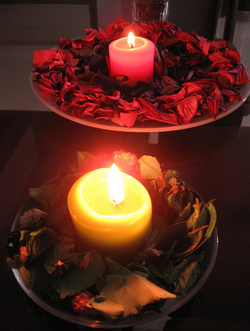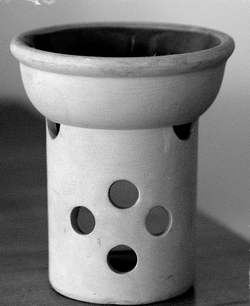Air fresheners

Air fresheners are commonplace in many homes, as a way of covering up cooking odors, musty smells, dank air and bathroom odors. In recent times, many commercially made air fresheners have relied on use of chemicals and artificial scents, as well as using electricity and materials such as plastics and metals to create complicated air fresheners that create rather strong odors in the home environment. They are not generally a sustainable product and there are many excellent alternatives to such air fresheners.
When seeking to freshen household or office air, always be sure to remove any unpleasant odor sources first. This is much more effective than simply trying to cover up foul odors and in some cases is a far healthier approach than letting molds, fungi and other unhealthy contaminants continue to grow unabated. Moreover, don't smoke indoors (preferably, don't smoke), as the smoke residue is both malodorous and unhealthy for all occupants. And keep your home well ventilated at all times of year.
Perils of chemical scents[edit | edit source]
Deodorizing the air with chemical air fresheners carries some potential health risks. For example, commercially available scents often contain such chemical ingredients as camphor, propane, benzene, formaldehyde, acetone, methanol, butane and paradichlorobenzene, which can harm the nervous system and may cause cancer. You hardly want to be spraying such chemicals around your personal space or your body.
Solid air fresheners, such as the deodorant cakes used for bathrooms, can be even worse in terms of what they contain chemically.
As for plug-in air fresheners, these tend to release volatile organic compounds into the air you're breathing, which is hardly comforting.
Some commercial air fresheners may be toxic in large amounts.[1]
Indoor air tends to more heavily contaminated than outdoor air, making it imperative that you're compounding the problem by adding more chemicals.
Using natural air fresheners[edit | edit source]
There are many natural air freshener options available straight from nature. These include:
- Fresh cut flowers, such as a bunch of roses or a vase of freesias
- Pine cones (either freshly cut or with essential oil added to them)
- Spices, either added to a potpourri or simmered on the stove
- Herbs, such as a posy of thyme and rosemary (often you'll need to rub or "bruise" herbs to release their essential oils)
- Squeezed citrus can often leave a fresh scent that lasts an hour or so
- The humble houseplant can clean air, leaving it fresher. Some plants are better suited to this purpose and indoor-living than others––do some research on which ones work best for your circumstances. NASA studies have shown that plants can effectively remove benzene, formaldehyde, xylene, toluene, acetone, methyl alcohol, ethyl acetate, ammonia, carbon monoxide and trichloroethylene from the air.
Simple air fresheners[edit | edit source]

There are many ways to make air fresheners from basic products that don't require a lot of trouble or expense. For example:
- Bicarbonate of soda (baking soda) can be used as an odor-eating base with essential oils or other scents added
- Potpourris
- Use leftover orange peels; add them to a small pan with a 1/2 teaspoon of cinnamon. Simmer over medium heat to release a lovely fragrance through your home.
- Liquid air fresheners for spraying or using in diffusers, made from alcohol and/or water bases with essential oils added
- Adding an essential oil or scented oil to a porous item such as a rock or wood that then scents the air or surrounding area
- A simple bowl of vinegar can capture many bad smells, leaving a neutral odor in a room
- Place a few drops of fragrant oil into a shallow dish of water––set on a sunny windowsill or radiator to warm the scent; as it evaporates, it will fill the room with its scent
- Place one or two drops of essential oil onto a light bulb; the warmth will diffuse the scent through the room
- Use soy based scented candles; always be in attendance when a candle is burning or blow it out if leaving the area unattended
- A few drops of essential oil added to a vacuum cleaner prior to cleaning leave a pleasant fragrance behind; baking soda sprinkled over the carpet before vacuuming will help to neutralize bad odors
- Add essential oil to a terracotta scent pot which can be hung in a wardrobe or pantry cupboard to release a pleasant odor
- For cars, place a few drops of oil on a tissue or cloth and stick into the air vent to refresh the air passing through (citrus oils and peppermint oils are good choices)
- Light a match over your toilet if it's especially smelly; it will consume the odor.
Note that burning essential oils can have a good effect on the health of your indoor air. Some essential oils will help to kill airborne bacteria and fungi, with top oils for this purpose including lavender, pine, thyme, peppermint and eucalyptus.
Recipes for air fresheners[edit | edit source]
For slightly more complex air fresheners, you can mix a few items to make some scented ones that please you most. There are many possibilities, just a few are provided here to give you an idea of how to mix and match different products to create an air freshener at home or for workplaces.
- Room freshener spray: 24-30 drops of essential oil; 500ml distilled water; 5ml vodka: Dissolve the essential oil in the vodka first. Then add this to the distilled water. Pour the liquid into a spray bottle and label it. Before spraying, always shake well. Use a fine-mist setting and avoid spraying over fabrics or anything that might stain.
- Dried herb freshener spray: 6-8 tbsp dried herb of choice; 10ml vodka; 500ml distilled water: Put the herbs into a glass or enamel saucepan. Add the water and bring to the boil. Once boiling, reduce to a simmer for 5 minutes. Remove from the heat and cover. Let steep overnight, then strain through muslin cloth. When pouring through, squeeze the herbs to remove the liquid. Add the alcohol and stir through, then pour into a spray bottle. Shake well before spraying.
- Spicy air freshener: Water; cloves; cinnamon; boiling water: Place the spices in the boiling water and simmer at the back of the stove. The scent will move from the stove throughout the room and possibly even beyond it. Keep an eye on it so that it doesn't evaporate and still be cooking.
- Baking soda spray: 2 tbsp baking soda, 2 cups hot water: Mix the baking soda with the hot water in a spray bottle. When all of the baking soda has dissolved, the liquid is ready to use as a spray. Spritz over areas that need deodorizing.
Sources[edit | edit source]
- ↑ Permacharts, Hazardous materials in the household
- http://greenlivingideas.com/2008/03/03/breathe-easy-with-natural-air-fresheners/
- Ellen Sandbeck, Organic Housekeeping
- Linda Mason Hunter and Mikki Halpin, Green Clean
See also[edit | edit source]
- Disease-repelling plants: these can be aerated using burners and can help in ie fighting malaria